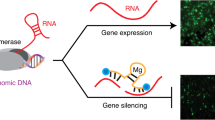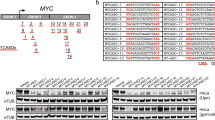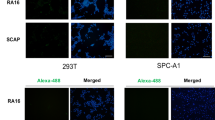Abstract
Thymidylate synthase (TS) catalyzes de novo production of thymidylate for DNA synthesis and cell proliferation. As such, TS has been a target of antitumor chemotherapy for many years. Our laboratory has identified several antisense oligodeoxynucleotides (ODNs) that downregulate TS mRNA and protein, inhibit cell proliferation, and sensitize cells to TS-directed chemotherapeutic drugs. Based on our observation that targeting distinct regions of the TS mRNA with a variety of antisense molecules resulted in differential effects on TS mRNA levels, it was hypothesized that use of multiple ODNs targeting distinct noncontiguous regions would result in synergistic or antagonistic interactions. In this study, we report that some combinations of TS antisense ODNs were more effective at reducing TS mRNA abundance and inhibiting cell proliferation than the individual ODNs used alone. However, in contrast to the effects on cell proliferation, the enhanced sensitivity to anti-TS chemotherapeutic drugs (i.e., raltitrexed and 5-fluorodeoxyuridine) that is achieved by treatment with individual ODNs was not further augmented by combined ODN treatment. This suggests that ODNs targeting TS mRNA inhibit an alternative function of TS mRNA or protein, distinct from thymidylate production. The results are evidence that the novel use of multiple antisense ODNs that target different regions of the same mRNA represents a general strategy to improve antisense effectiveness.
This is a preview of subscription content, access via your institution
Access options
Subscribe to this journal
Receive 12 print issues and online access
$259.00 per year
only $21.58 per issue
Buy this article
- Purchase on Springer Link
- Instant access to full article PDF
Prices may be subject to local taxes which are calculated during checkout







Similar content being viewed by others
References
Carreras CW, Santi DV . The catalytic mechanism and structure of thymidylate synthase. Annu Rev Biochem. 1995;64:721–762.
Danenberg PV . Thymidylate synthetase—a target enzyme in cancer chemotherapy. Biochim Biophys Acta. 1977;473:73–92.
Danenberg PV, Malli H, Swenson S . Thymidylate synthase inhibitors. Semin Oncol. 1999;26:621–631.
Papamichael D . The use of thymidylate synthase inhibitors in the treatment of advanced colorectal cancer: current status. Oncologist. 1999;4:478–487.
Smith JB, Wickstrom E . Preclinical antisense DNA therapy of cancer in mice. Methods Enzymol. 2000;314:537–580.
Gewirtz AM . Oligonucleotide therapeutics: a step forward. J Clin Oncol. 2000;18:1809–1811.
Ferguson PJ, Collins O, Dean NM, et al. Antisense down-regulation of thymidylate synthase to suppress growth and enhance cytotoxicity of 5-FUdR, 5-FU and Tomudex in HeLa cells. Br J Pharmacol. 1999;127:1777–1786.
Berg RW, Werner M, Ferguson PJ, et al. Tumor growth inhibition in vivo and G2/M cell cycle arrest induced by antisense oligodeoxynucleotide targeting thymidylate synthase. J Pharmacol Exp Ther. 2001;298:477–484.
Sato N, Mizumoto K, Maehara N, et al. Enhancement of drug-induced apoptosis by antisense oligodeoxynucleotides targeted against Mdm2 and p21WAF1/CIP1. Anticancer Res. 2000;20:837–842.
Traidej M, Chen L, Yu D, Agrawal S, Chen J . The roles of E6-AP and MDM2 in p53 regulation in human papillomavirus-positive cervical cancer cells. Antisense Nucleic Acid Drug Dev. 2000;10:17–27.
Normanno N, Bianco C, Damiano V, et al. Growth inhibition of human colon carcinoma cells by combinations of anti-epidermal growth factor-related growth factor antisense oligonucleotides. Clin Cancer Res. 1996;2:601–609.
Skorski T, Nieborowska-Skorska M, Campbell K, et al. Leukemia treatment in severe combined immunodeficiency mice by antisense oligodeoxynucleotides targeting cooperating oncogenes. J Exp Med. 1995;182:1645–1653.
Skorski T, Nieborowska-Skorska M, Wlodarski P, et al. Antisense oligodeoxynucleotide combination therapy of primary chronic myelogenous leukemia blast crisis in SCID mice. Blood. 1996;88:1005–1012.
DeMoor JM, Vincent MD, Collins OM, Koropatnick J . Antisense nucleic acids targeted to the thymidylate synthase (TS) mRNA translation start site stimulate TS gene transcription. Exp Cell Res. 1998;243:11–21.
Spears CP, Gustavsson BG . Methods for thymidylate synthase pharmacodynamics: serial biopsy, free and total TS, FdUMP and dUMP, and H4PteGlu and CH2-H4PteGlu assays. Adv Exp Med Biol. 1988;244:97–106.
Hoganson DK, Williams AW, Berger SH . Isolation and characterization of a thymidylate synthase-deficient human colon tumor cell line. Biochem Pharmacol. 1999;58:1529–1537.
Omura K, Morishita M, Kawakami K, et al. Quantification of thymidylate synthase gene expression in human gastrointestinal carcinoma tissues using competitive PCR. Hepatogastroenterology. 1999;46:985–990.
Chu E, Koeller DM, Casey JL, et al. Autoregulation of human thymidylate synthase messenger RNA translation by thymidylate synthase. Proc Natl Acad Sci USA. 1991;88:8977–8981.
Chu E, Voeller DM, Jones KL, et al. Identification of a thymidylate synthase ribonucleoprotein complex in human colon cancer cells. Mol Cell Biol. 1994;14:207–213.
Mathews DH, Sabina J, Zuker M, et al. Expanded sequence dependence of thermodynamic parameters improves prediction of RNA secondary structure. J Mol Biol. 1999;288:911–940.
Zuker M, Mathews DH, Turner DH . Algorithms and thermodynamics for RNA secondary structure prediction: a practical guide. In: Barciszewski J, Clark BFC, (eds). RNA Biochemistry and Biotechnology. New York, NY: Kluwer Academic Publishers;1999:pp. 11–43.
Ho SP, Scully MS, Krauthauser CM, et al. Antisense oligonucleotides selectively regulate aspartyl beta-hydroxylase and its truncated protein isoform in vitro but distribute poorly into A549 tumors in vivo. J Pharmacol Exp Ther. 2002;302:795–803.
Kandimalla ER, Manning A, Lathan C, Byrn RA, Agrawal S . Design, biochemical, biophysical and biological properties of cooperative antisense oligonucleotides. Nucl Acids Res. 1995;23:3578–3584.
Gewirtz AM, Stein CA, Glazer PM . Facilitating oligonucleotide delivery: helping antisense deliver on its promise. Proc Natl Acad Sci USA. 1996;93:3161–3163.
Lebedeva I, Stein C . Antisense oligonucleotides: promise and reality. Annu Rev Pharmacol Toxicol. 2001;41:403–419.
Acknowledgements
This work was supported by funds awarded to MV and JK by Zeneca Pharma Canada, Ltd, and Imperial Oil, Ltd. We thank Charlene Stirling, Helen Guenther, and Natalia Naraine for excellent technical assistance, and Mike Keeney (London Health Sciences Centre) for flow cytometry analysis. We also thank Dr Nicholas Dean (ISIS Pharmaceuticals, Carlsbad, CA) for supplying ODNs, and Astra Zeneca, Inc. (Macclesfield, UK) for supplying raltitrexed (Tomudex®).
Author information
Authors and Affiliations
Corresponding author
Rights and permissions
About this article
Cite this article
Berg, R., Ferguson, P., Vincent, M. et al. A “combination oligonucleotide” antisense strategy to downregulate thymidylate synthase and decrease tumor cell growth and drug resistance. Cancer Gene Ther 10, 278–286 (2003). https://doi.org/10.1038/sj.cgt.7700566
Received:
Published:
Issue Date:
DOI: https://doi.org/10.1038/sj.cgt.7700566



